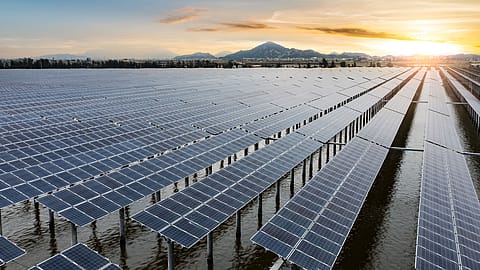Overcapacity, margin squeeze and consolidation stare at India’s booming solar equipment industry
A series of policy interventions under Atma Nirbhar Bharat — the Approved List of Models and Manufacturers (ALMM), which almost blocked imports, basic customs duties on imported modules and cells, and the production-linked incentive (PLI) scheme, changed the domestic industry landscape.

India’s solar manufacturing engine has raced ahead in the past decade — but it is heading into a roadblock - the problem of plenty. From a modest 2.3 gigawatt (GW) of solar module capacity in 2014, the country now boasts 109 GW of capacity, supported by 100 manufacturers and 123 production units. Yet this rapid expansion is now running into the hard reality of demand. With annual solar installations expected to be only 45–50 GW - against 60–65 GW of available module production - the industry is staring straight at an overcapacity issue, say experts.
A fast-growing domestic solar industry
Until 2014, India depended almost entirely on China for solar cells and modules to meet its ambition of reaching 500 GW of renewable energy capacity by 2030. A series of policy interventions under Atma Nirbhar Bharat — the Approved List of Models and Manufacturers (ALMM), which almost blocked imports, basic customs duties on imported modules and cells, and the production-linked incentive (PLI) scheme, changed the domestic industry landscape.
The ALMM order came into force in January 2019. When the first list was published in March 2021, India had just 8.2 GW of enlisted module capacity across 21 manufacturers. In just over four years, this surged more than twelvefold to 100 GW of ALMM-listed capacity, with the number of manufacturers rising nearly fivefold to 100, with 123 manufacturing units.
As of September 2025, India’s manufacturing base stands at 109 GW of modules and 17.9 GW of cells — one of the fastest build-outs globally. And yet, the expansion continues.
The Problem of Plenty
Industry projections indicate that India’s module capacity will touch 130 GW and cell capacity 35 GW by March 2026. By March 2027, capacities may reach 165 GW for modules and 70 GW for cells. The implementation of ALMM List-II for solar PV cells from June 2026 has fuelled further investments in cell lines by module makers.
Recommended Stories
“Cell manufacturing capacity is likely to grow to about 100 GW by December 2027, from 17.9 GW currently under ALMM,” notes rating agency ICRA.
Domestic installation demand — at 45–50 GW per year — simply cannot absorb the 60–65 GW of modules rolling off production lines annually. And with the recent US tariffs redirecting exports back to India, the domestic glut is worsening, say sources.
On the Cusp of Consolidation
ICRA expects overcapacity to squeeze margins and accelerate consolidation among the country’s 100-odd OEMs. Seven large players today control nearly half of India’s installed module capacity, and that share is likely to rise as smaller players come under pressure.
“The operating profitability of domestic solar OEMs, which stayed elevated at 25% in FY2025, is set to moderate due to competitive pressures and overcapacity,” says Ankit Jain, Vice President & Co-Group Head, Corporate Ratings, ICRA.
Adding to their challenges is the increase in uncertainty in the US — a key export market — following new tariff measures. The redirection of shipments to India is likely to intensify price competition further.
There’s also a cost disadvantage. Modules made with domestic cells cost 3–4 cents per watt more than those made with imported cells. While modules using imported cells land at around 16 cents/W, domestically sourced cells push the cost to 19.5 cents/W, says the ICRA analysis.
A reprieve comes from the exemption available to projects whose bid submission deadline falls before September 1, 2025 — a 45–50 GW pipeline that will not require ALMM-listed domestic cells even after June 2026. This should support non-integrated OEMs in the near term, although bidding activity has slowed recently, observes ICRA.
Despite India’s impressive strides, China still towers over the global solar supply chain — accounting for over 90% of polysilicon and wafer, 85% of cell, and 80% of module manufacturing capacity worldwide. Indian manufacturers remain heavily dependent on imported wafers and ingots, leaving them vulnerable to geopolitical risks and supply disruptions.
Backward integration into polysilicon and wafer manufacturing demands far higher technological sophistication — and billions in capital. Building these capacities, stabilising them, and reducing China-dependence remain among the toughest challenges ahead. Already, large corporates like Reliance Industries and Adani Group are investing billions to create an entire solar equipment value chain.